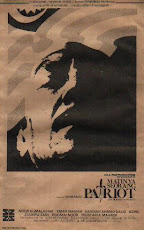#319. Sinematografi : Shades of noir, a study in contrast
"LIGHT is an incredible thing that can't be described," cinematographer Stanley Cortez once said. "Only two of the directors I've worked with have understood it: Orson Welles and Charles Laughton."
During his 50-year career, Cortez was known for his mastery of composition, deep focus and light in such atmospheric black-and-white movies as Welles' 1942 drama, "The Magnificent Ambersons," and Laughton's only film as a director, the sinister 1955 thriller "The Night of the Hunter." "He was very high on contrast lighting," says film historian Chris Horak, curator of the Hollywood Entertainment Museum. "In the 1940s, as other cinematographers are going for gray tones, he is going much more for black-and-white effect. He is clearly working almost in a film noir style."
Several examples of Cortez's best work in the black-and-white medium will be featured in the Los Angeles County Museum of Art's retrospective "Let There Be Light: The Black-and-White Cinematography of Stanley Cortez," which opens Friday with "The Magnificent Ambersons" and the 1941 horror comedy "The Black Cat." Welles was so inspired by Cortez's work on the low-budget "Black Cat," which is primarily set in an old, dark house, that the director hired him for "Ambersons."
Cortez was born Stanislaus Kranz in New York City in 1908 to Austrian Jewish immigrant parents. His older brother, Jacob, went to Hollywood as an actor in the 1920s, and the studio soon transformed him into a Latin lover by the name of Ricardo Cortez. When Stanislaus followed his brother to Tinseltown, he changed his name to Stanley Cortez.Cortez began his career in New York in the 1920s working as an assistant to Edward Steichen during the photographer's portrait period. From Steichen, Cortez learned the skill of lighting faces.He soon made the leap to moving pictures. Watching a parade one day, Cortez introduced himself to Willard Van der Veer, a newsreel cameraman for Pathe Revue, who was covering the event.
Van der Veer helped Cortez get a job as an assistant on the 10-part 1925 serial "The Green Archer." When he moved to Hollywood, he worked as an assistant to such cinematographers as Tony Guadio, Karl Struss and Oliver Marsh. He segued to filming screen tests at Universal, and in 1937 he was promoted to head of photography for the "B" unit at the studio, where his cinematography was usually the highlight of such forgettable films as "Danger on the Air" and "Personal Secretary."
Though Cortez received an Oscar nomination for "Ambersons," his perfectionism led to delays and cost overruns. Eventually RKO cut the film by 50 minutes and reshot the ending without Cortez's or Welles' participation. Two years later, Cortez received his last nomination, for the glossy David O. Selznick war melodrama "Since You Went Away."
Throughout his career, which ended in 1980 with his miniature photography for the Irwin Allen disaster film "When Time Ran Out," Cortez worked on classy pictures as well as such turkeys as "Navy Vs. the Night Monsters" and "The Ghost in the Invisible Bikini." "He still belonged to a generation that worked [all the time]," says Horak. "Some things he put his heart into and others he didn't."
In addition to "Ambersons" and "Hunter," the retrospective features Cortez's work on the 1946 John Huston documentary, "Let There Be Light," chronicling the traumas suffered by World War II vets; 1947's "Smash-Up: The Story of a Woman," a stark drama of alcoholism; and Sam Fuller's 1963 cult favorite, "Shock Corridor," a melodrama set at a mental hospital.
Cortez became a highly vocal opponent to the colorization of black-and-white movies in the late 1980s.In 1989, he told the U.S. Senate Subcommittee on Patents, Copyrights and Trademarks:
"I know that perhaps some young people in America today scorn the impressionistic beauty of the classic black-and-white films -- the master achievement of Hollywood's golden era. But because some people do not appreciate the black--and-white picture does not mean all should be robbed of seeing a classic in its original beauty and splendor
Cortez died in 1997.







0 ulasan:
Catat Ulasan